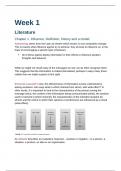Week 1
Literature
Chapter 1. Influence: Definition, history and a model
Advertising stems from the Latin ad vertere which means ‘to turn towards/to change’.
This is exactly what influence agents try to achieve: they all seek to influence us, in the
hope of encouraging a specific type of behavior.
All of these agents deploy information in their efforts to influence people’s
thoughts and behavior.
While we might not recall many of the messages we see, we do often recognize them.
This suggests that the information is indeed internalized, perhaps in ways many times
subtler than we might suspect at first sight.
In Harold Lasswell’s view, the effectiveness of information is best understood by
asking ourselves ‘who says what in which channel from whom, with what effect?’ In
other words, it is important to look at the characteristics of the person issuing the
message (who), the content of the information being communicated (what), the medium
used to transmit it (which channel), the characteristics of the intended recipient (to
whom) and the extent to which their opinions or preferences are influenced as a result
(what effect).
An attitude describes an evaluative response – positive or negative – to a person, a
situation, a product, an idea or an organization.
,Hovland’s findings included the discovery that factors like the reliability and expertise of
the source help to determine how a message affects the recipient’s attitudes and
behavior.
Hovland and his colleagues soon realized that the direct impact of a message
often differs from its indirect or delayed effect.
Based on their findings concerning the dynamics of attitudinal and behavioral
change, Hovland’s team devised a four-step process model of persuasion.
1. Attention: first, people must pay attention to the information contained in a
message.
2. Understanding: Secondly, the message must be presented in such a way that
it is understood.
3. Acceptance: once it is, the recipient can accept it and modify their attitude
accordingly.
4. Retention: but for that change to influence their behavior permanently, the
recipient must also retain their new attitude.
Information that corresponds with the ideas and attitudes a person already holds dear is
more persuasive than a message which contradicts them. These findings are
summarized in the Yale model of persuasion.
The model asserts only that motivated people will take in information; it does not
state how exactly that process works or whether its machinations affect the
eventual outcome.
William McGuire’s inoculation theory sets out how people can arm themselves against
information intended to influence and change their opinion.
, He identifies six steps rather than four: presentation, attention, comprehension,
yielding, retention and, finally, behavior. In his view, the steps are more
dynamically related and can influence each other.
Anthony Greenwald further developed McGuire’s ideas in his cognitive response
theory.
His work examines the way in which information is processed and how that
affects attitudes.
In advertising and marketing, models were being developed to describe the steps that
can result in the recipient of a message being influenced. One of the earliest of these
was the AIDA model that stands for ‘Attention, Interest, Desire, Action’.
Key factors in influence:
, The various forms of processing can be presented as a continuum, as in Figure 1.5.
Based upon the amount of cognitive effort devoted to the process, this runs from more
or less automatic influence at one end of the scale to techniques at the other extreme
which assume that people will carefully and systematically consider the information they
are provided with.
Chapter 2. Theoretical Foundations of Campaigns
The most popular theory of how persuasive communication operates is sketched in the
input/output matrix displayed in Figure 2.1. The inputs (the column labels) include the
various components out of which one can construct the communication to change
attitudes and actions; the output steps (the rows) consist of the successive information-
processing behavioral substeps that the communication must evoke in the target person
for the persuasive impact to occur.





